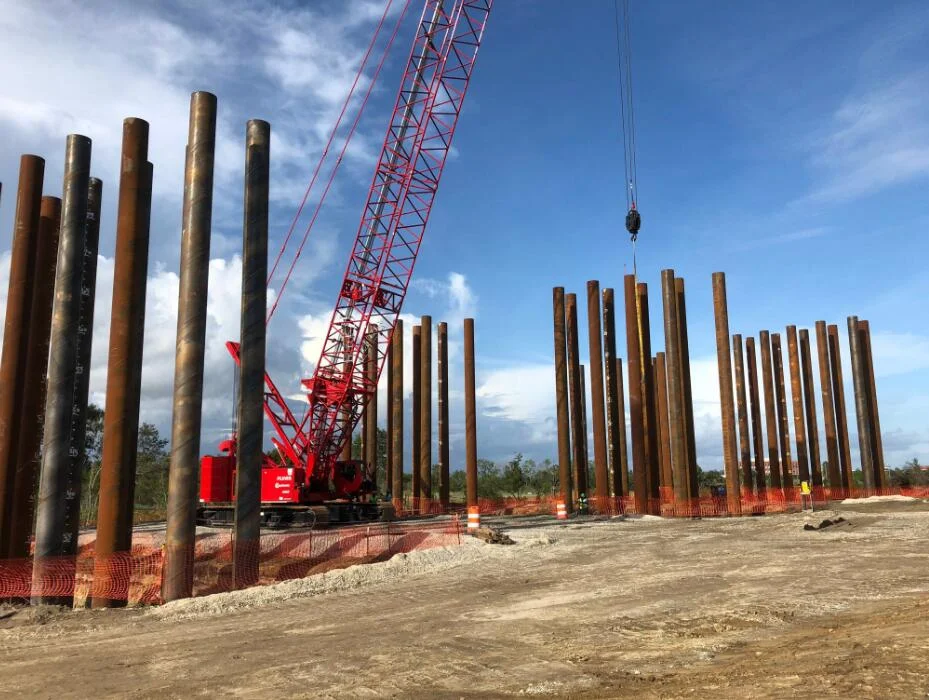Problems encountered during piling of steel pipe piles and their solutions
Analysis of problems encountered

The problems usually encountered in the piling process of micro steel pipe pile are:
①Failed to hit the design depth;
② The pile body is damaged;
③Although it has reached the design depth, it cannot be stopped;
④ The deviation or inclination of the pile exceeds the allowable value;
⑤Compared with the record of foundation survey or test pile, the driving condition of pile is quite different.
The analysis of the above problems may include: relative to the pile shape, section and foundation condition, the weight of the pile hammer is not appropriate; the selection and use of the pile cap and cushion are wrong, which leads to too much energy loss; the pile It is caused by the poor counterweight of the hammer; large offset due to poor positioning or improper management; insufficient investigation of the foundation, and no obstacles such as hard interlayers and boulders in the stratum have been found; due to the pair of piles The compaction of the soil and the too small spacing between piles cause the friction around the pile to increase; the contact surface between the “replacement” of the pile sending and the pile head is not good or falls off.
No matter what the situation is, when the pile cannot be driven in smoothly, it must be stopped and dealt with. Some have to do after-treatment, and miss work. Therefore, it is very important to conduct preliminary investigation and adequate construction management before pile driving.
Countermeasures when it is difficult to enter the pile
When the pile cannot be driven, corresponding countermeasures should be taken first for the above reasons.
If the pile is not damaged and cannot be driven in, it can be considered as a problem with the equipment. That is, the diesel hammer hits 0.5mm at a time, and the gasoline hammer is basically the same. When the vibrating hammer penetrates below 25mm per minute, or the amplitude drops below the rated 1/3-1/5. In the process of piling, the driving records should be made as detailed as possible, which is conducive to analyzing the cause of the accident and making an appropriate solution. The following are common problems and solutions:
①The diesel hammer is suitable. When encountering hard formations that cannot be penetrated, the drop distance of the hammer should exceed 2-2.2m. If it is unable to drive in at a distance greater than the drop distance, it may be caused by poor oil delivery or improper selection of cushioning pads.
② If the record deviation of several piles is very large, it is due to obstacles in the ground.
③ When the amount of rebound is large and the amount of soil and sand in the pile is small, it is caused by damage to the pile tip or underground obstacles.
Sometimes the following measures are taken: use a larger hammer; whether it is possible to stop driving; change the pile tip and pile section to change the closed pile to the open pile to reduce the driving resistance.
In the process of driving, if the pile is damaged, the following measures can be taken in principle.
①If it is damaged during lifting, it is best to replace one first.
②The pile head is damaged when the driving is completed (generally limited to the head and has no effect on the pile body). When the length is not sufficient and the damaged length is about lm, the head can be dug out, reinforced and hooped, and concrete is poured. But when the damage length is relatively large, it is better to drive in new piles.
③In principle, when the pile body is damaged during driving, a new pile must be driven. However, the pile has been driven, and the damage is not too serious, and the designer has approved it to be used, so the micro-steel pile must be filled with concrete for reinforcement.
When the bearing capacity is insufficient, in principle, the pile should be connected according to the judgment of the pile driving record, so that the pile can obtain the specified bearing capacity.
Interruption of piling operations. During the period from start to stop, long-term interruptions should be avoided as much as possible, or interruptions caused by observing the operating time. During the piling process, leave the operation until the next day. Such a long-term interruption will cause friction around the pile. Recovered and it is difficult to continue to penetrate. Therefore, in addition to formulating a plan not to interrupt production, while carrying out equipment and power source equipment maintenance, it is also necessary to have equipment that can still drive down piles due to increased friction.






